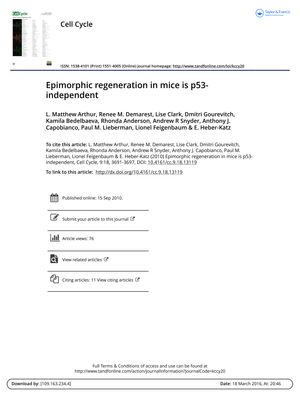TLDR Mice can regenerate ear tissue without the p53 protein.
The study explored the role of the p53 protein in the regenerative process of ear hole closure in MRL mice, a model for mammalian epimorphic regeneration. It was found that the absence of p53 did not hinder the healing ability of MRL mice; in fact, these mice showed an increased level of adipocytes and chondrocytes in the healing tissue compared to MRL or p21-null mice. The research also indicated that other cell cycle-related proteins, such as p16 and Gadd45, are important for regeneration, as mice lacking these proteins exhibited little healing. The study suggests that p53 signaling is not essential for mouse appendage regeneration and that p21 may be involved in the regenerative process through a p53-independent pathway, potentially involving the Tgfß/Smad pathway. The findings imply that p53-induced senescence is not a requirement for tissue regeneration in this model, and that the interaction between p53 and p21 in MRL mice may be defective.
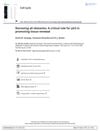 30 citations
,
April 2010 in “Cell Cycle”
30 citations
,
April 2010 in “Cell Cycle” The gene p53 is crucial for removing damaged cells to allow for healthy tissue renewal.
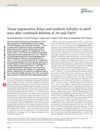 99 citations
,
August 2009 in “Nature Genetics”
99 citations
,
August 2009 in “Nature Genetics” Removing both Atr and Trp53 genes in adult mice causes severe tissue damage and death due to DNA damage.
 27 citations
,
January 2012 in “Current Topics in Microbiology and Immunology”
27 citations
,
January 2012 in “Current Topics in Microbiology and Immunology” Mice that can regenerate tissue have cells that pause in the cell cycle, which is important for healing, similar to axolotls.
 1 citations
,
May 2017 in “InTech eBooks”
1 citations
,
May 2017 in “InTech eBooks” Hair loss in Androgenetic alopecia (AGA) is due to altered cell sensitivity to hormones, not increased hormone levels. Hair growth periods shorten over time, causing hair to become thinner and shorter. This is linked to miscommunication between cell pathways in hair follicles. There's also a change in gene expression related to blood vessels and cell growth in balding hair follicles. The exact molecular causes of AGA are still unclear.
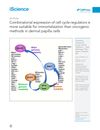 5 citations
,
January 2021 in “iScience”
5 citations
,
January 2021 in “iScience” Using a combination of specific cell cycle regulators is better for safely keeping hair root cells alive indefinitely compared to cancer-related methods.
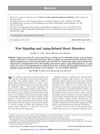 59 citations
,
November 2010 in “Circulation Research”
59 citations
,
November 2010 in “Circulation Research” Wnt signaling may be linked to heart diseases in aging and could be a target for future treatments.
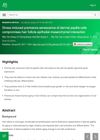 35 citations
,
January 2017 in “Journal of Dermatological Science”
35 citations
,
January 2017 in “Journal of Dermatological Science” Stress can cause early aging in certain skin cells, leading to problems with hair growth.
